Whether it's for your personal blog or your online shop site , knowing image optimization according to search engine optimization (SEO) rules is a must.
At first glance, maybe you see pictures as decoration only.
Have a trace, that image can help you attract more visitors, you know. Especially if you practice SEO and use the right keywords .
Want to know what to pay attention to when doing image optimization? Listen further, let's!
Image Optimization Tips for SEO
1. Name the image descriptively

The first tip is to name the image as descriptively as possible, but don't need to be wordy.
Make sure when doing image optimization for SEO, insert targeted keywords in the file name .
Citing the Search Engine Journal , the image file name will help search engine crawlers find out what topics are in the image.
Do not use file names such as, “180092.jpg”, “image (2)”, and others.
Say you are selling electric air freshener under the XYZ brand. It is recommended to include the specifications in the file name as well .
For example, "XYZ Air Freshener 2020 new grape". That way, when people search for these keywords , their image will most likely come up first.
2. Don't forget about the alt attribute

The use of alt attributes in images can help the SEO optimization process, which will improve the user experience, you know.
The reason is, there are often people who cannot view images in their browser either because of settings or internet connection only.
Reporting from Yoast , alt text or alt tags seo optimalizace are tags that contain photo descriptions (describing what, whether to use appropriate keywords or not).
So, even if the image does not appear, the reader can know at least what the image shows.
Not only for readers, search engines also need this data in order to display it when people search using similar keywords .
3. Make sure the image format and size are adjusted

When optimizing images according to SEO requirements, the three main things that must be considered are the format, size and quality of the image.
It is recommended to use the right format, the image size is not too large, but still prioritizes the quality.
The reason is, images that are too large can increase the bounce rate , you know.
Just waiting for a few seconds to load a page can make customers run away, especially if you add an incomplete picture or shape?
For images, it is recommended to use the PNG or JPEG format. You can compress the size so that it is not too big, a maximum (approximately) 100 KB.
4. Select the right angle

Be it on e-commerce or personal sites, make sure all angles of the product are displayed, yes.
That way, customers can see all parts of the product. Don't forget to name the file according to the angle shown.
For example, "XYZ Air Freshener grape inside" or "XYZ Air Freshener grape battery", and others.
5. Use a sitemap for images

Another tip for SEO image optimization is to utilize a sitemap for each image uploaded on the site.
Whether it's inserting images into your sitemap or creating a new sitemap specifically for images.
This sitemap will later help the web crawlers work process in indexing the images on your site.
It is advisable to use specific tags in each image and include important information.
6. Thumbnail image size should not be too big
Just like regular images, sometimes thumbnails are forgotten and they are detrimental.
Well, the last tip is to make sure the image used for the thumbnail is not too big.
At the beginning, Glints did suggest prioritizing quality. However, the main thumbnail function doesn't require that.

No comments:
Post a Comment